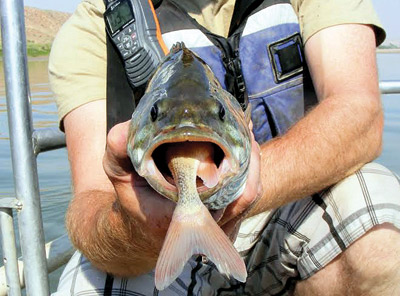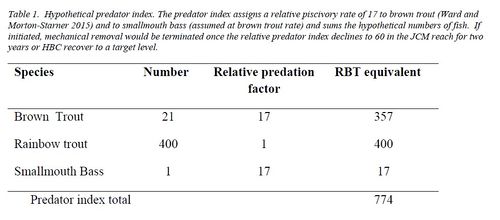Difference between revisions of "Nonnative Invasive Aquatic Species"
Cellsworth (Talk | contribs) |
Cellsworth (Talk | contribs) |
||
| Line 123: | Line 123: | ||
'''1992''' | '''1992''' | ||
*[http://www.nativefishlab.net/library/textpdf/20950.pdf| Nonnative fishes of the Grand Canyon; A review with regards to their effects on native fishes. Allen Haden, GCES] | *[http://www.nativefishlab.net/library/textpdf/20950.pdf| Nonnative fishes of the Grand Canyon; A review with regards to their effects on native fishes. Allen Haden, GCES] | ||
| + | |||
| + | |- | ||
| + | ! <h2 style="margin:0; background:#cedff2; font-size:120%; font-weight:bold; border:1px solid #a3b0bf; text-align:left; color:#000; padding:0.2em 0.4em;"> [[Media:Appendix D Final Chub Triggers 2017.pdf| LTEMP BiOp Triggers for Nonnative Removals (LTEMP BA Appendix D)]] </h2> | ||
| + | |- | ||
| + | |style="color:#000;"| | ||
| + | |||
| + | === '''Tier 1 Trigger – Early Intervention Through Conservation Actions:''' === | ||
| + | |||
| + | *1a. If the combined point estimate for adult HBC (adults defined ≥200 mm) in the Colorado River mainstem LCR aggregation; RM 57-65.9) and Little Colorado River (LCR) falls below 9,000 as estimated by the currently accepted HBC population model (e.g., ASMR, multi-state). | ||
| + | |||
| + | -OR- | ||
| + | |||
| + | *1b. If recruitment of sub-adult HBC (150-199mm) does not equal or exceed estimated adult mortality such that: | ||
| + | |||
| + | # Sub-adult abundance falls below a three-year running average of 1,250 fish in the spring LCR population estimates, or | ||
| + | # Sub-adult abundance falls below a three-year running average of 810 fish in the mainstem Juvenile Chub Monitoring reach (JCM annual fall population estimate; RM 63.45-65.2). | ||
| + | |||
| + | Tier 1 Trigger Response: | ||
| + | *Tier 1 conservation actions listed below will be immediately implemented either in the LCR or in the adjacent mainstem. Conservation actions will focus on increasing growth, survival and distribution of HBC in the LCR & LCR mainstem aggregation area. | ||
| + | |||
| + | === '''Tier 2 Trigger - Reduce threat using mechanical removal if conservation actions in Tier 1 are insufficient to arrest a population decline:''' === | ||
| + | Mechanical removal of nonnative aquatic predator will ensue: | ||
| + | *If the point abundance estimate of adult HBC decline to <7,000, as estimated by the currently accepted HBC population model. | ||
| + | |||
| + | Mechanical removal will terminate if: | ||
| + | *Predator index (described below) is depleted to less than 60 RBT/km for at least two years in the JCM reach and immigration rate is low (the long term feasibility of using immigration rates as a metric still needs to be assessed), | ||
| + | -OR- | ||
| + | *Adult HBC population estimates exceed 7,500 and recruitment of sub-adult chub exceed adult mortality for at least two years. | ||
| + | |||
| + | [[File:PredatorIndexTable.jpg|center|500px]] | ||
| + | |||
| + | If immigration rate of predators into JCM reach is high, mechanical removal may need to continue. These triggers are intended to be adaptive based on ongoing and future research (e.g., Lees Ferry recruitment and emigration dynamics, effects of trout suppression flows, effects of Paria River turbidity inputs on predator survival and immigration rates, interactions between humpback chub and rainbow trout, other predation studies). | ||
|- | |- | ||
Revision as of 13:28, 21 March 2017
|
|
Nonnative Invasive Aquatic SpeciesNon-native fish species present in Grand Canyon were mostly established as a result of intentional stocking to develop sport fisheries in the Colorado River and its tributaries during the late 1800s and early 1900s. Impacts of these actions was not fully understood until later in the 20th Century when a shift to native species conservation management occurred in the NPS. Negative impacts of non-native fish and altered habitats on native fish species has been well-documented throughout the world. Over 20 non-native fish species have been documented in GCNP; However, the more common, large-bodied, species of management concern include rainbow and brown trout, common carp, channel catfish, and bullhead species, striped and smallmouth bass. These species are known predators on native fish or native fish eggs or compete with native fish species. (NPS CFMP-EA_Pg 62) (17 warmwater species, 2 coldwater species, and 1 coolwater species)--- At least 7 additional species occur in nearby or adjoining waters with potential access to the Glen Canyon Ecosystem. LTEMP Experimental Action: Aquatic Resource-Related Experimental Treatments (BA, pages 30-41) [1]Nonnative fish control actions would be implemented if the Little Colorado River humpback chub population declined and proactive conservation actions failed to reverse declining populations [2]. Mechanical removal of nonnative species is a controversial issue in the Colorado River through Glen and Grand Canyons. A spring 2015 meeting of Grand Canyon biologists (NPS, FWS, AGFD, GCMRC) to assess current trout removal triggers resulted in a concept of early conservation measure intervention to maximize conservation benefit to humpback chub and minimize the likelihood of mechanical predator removal. Under the preferred alternative, mechanical removal of nonnative rainbow and brown trout (and other nonnative predators) would be implemented through a triggered, tiered approach (see Appendix D in BA) near the confluence of the Little Colorado River and the Colorado River if conservation actions designed to reverse declines in the Little Colorado River humpback chub aggregation were ineffective. Two different tiers of population metrics would be used to trigger responses such as actions to increase growth and survival of humpback chub (Conservation Actions, Tier 1), or mechanical nonnative fish control (Tier 2), which would only be implemented when Tier 1 conservation actions (actions would focus on increasing growth, survival and distribution of chub in the Little Colorado River and LCR mainstem aggregation area) fail to slow or reverse the decline in the humpback chub population (see Appendix D in BA, Young et al. 2015). In addition, if humpback chub decline and the identified actions are not working, the FWS, in coordination with action agencies and traditionally associated Tribes, will identify future appropriate actions (among other caveats specified in Young et al. 2015). |
| Online training |
Fish Species of the Colorado River in Lower Glen Canyon and Grand Canyon |
Fish photos, information, and maps |
|---|
Potential Threats:
|
|

